From Chaos to Cohesion: The Power of Full-Stack Product Engineering Services
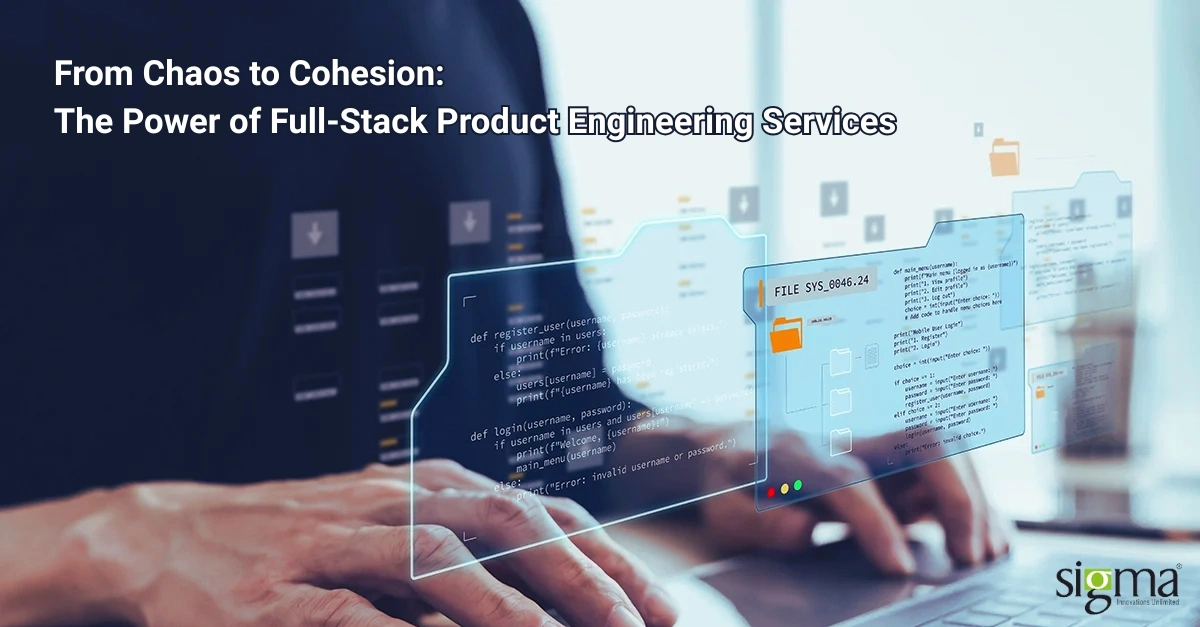
Let’s face it — building digital products today can feel like trying to assemble a 1,000-piece puzzle in the dark.
The digital-first world? It’s all about lightning speed. Product cycles are shrinking, customer expectations are climbing, and the enterprise’s internal teams are? They’re often working in silos—engineering over here, design over there, and product strategy somewhere in the cloud. It’s no wonder product development feels chaotic.
Sound familiar? You’re not alone. Many tech-first companies struggle with misaligned goals, fragmented toolsets, inconsistent user experiences, and delays that push releases from Q1 to…well, who knows when.
This is where full-stack product engineering services step in like a well-oiled engine—bringing cohesion, speed, and clarity to an otherwise messy machine. By bridging every layer of the stack—from front-end to back-end, cloud to QA—a dedicated product engineering team ensures everything runs in sync. No more piecemeal outsourcing. No more guessing games. Just seamless execution with clear ownership.
In this blog, we’ll explore:
- The growing need for full-stack collaboration
- Why piecemeal approaches no longer work
- How software product engineering services are reshaping innovation for FinTech, eCommerce, and other businesses
- And how you can turn development chaos into a growth-driving advantage
Whether you’re building your next SaaS platform or looking for custom product development, this post is for you.
Defining Full-Stack Product Engineering in 2025: Concept to Launch—and Beyond
In 2025, full-stack product engineering services will be more than just “developers who do front-end and back-end.” It’s a mindset — one where the entire product lifecycle, from ideation to deployment and beyond, is managed under one cohesive umbrella.
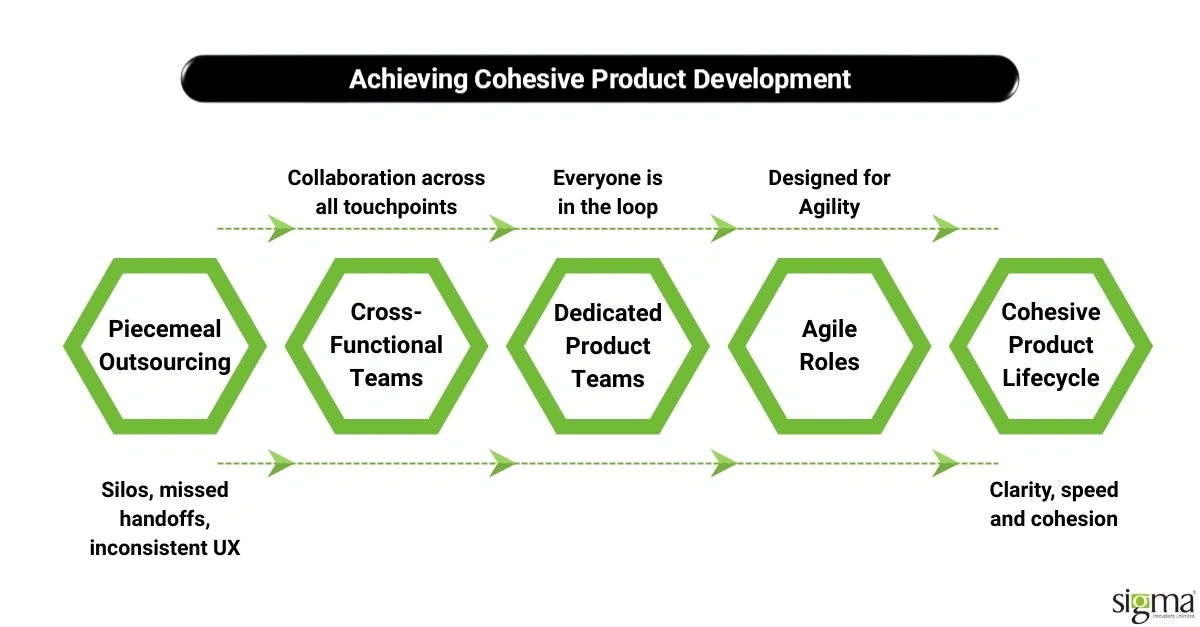
Think of it like building a smart home. You wouldn’t hire five different contractors to handle wiring, plumbing, insulation, and design, right? You’d want a team that talks to each other, works toward the same goal, and sees the full picture. That’s what software product engineering services bring to digital product development.
At its core, full-stack product engineering means cross-functional collaboration across all touchpoints of product creation. We’re talking about:
- Front-end and back-end development
- DevOps and cloud infrastructure
- QA and automation
- Data engineering and performance optimization
- Continuous delivery and feedback loops
Gone are the days when teams worked in silos — developers shipping code without knowing the end-user, or QA discovering bugs three weeks too late. With a dedicated product engineering team, everyone’s in the loop. Everyone’s invested. And that means faster iteration, fewer delays, and products that actually meet user expectations.
Contrast this with the traditional development model, where things often feel like a game of telephone. Designers hand off to developers, who pass things to testers, who then circle back to product managers — all while objectives get blurry and timelines stretch. That’s the danger of piecemeal outsourcing, where each function works in isolation. What are the limitations of piecemeal outsourcing? Missed handoffs, inconsistent UX, and a lack of ownership.
Modern full-stack teams break this cycle. Roles like Full-Stack Engineer, Product Engineer, and Productized Teams are designed for agility. These professionals don’t just write code — they understand the business logic, user flows, technical constraints, and how all the moving parts connect.
And it’s not just for startups anymore. From FinTech product development outsourcing to product engineering for SaaS companies, enterprise players are now investing in digital product engineering services to scale smarter, faster, and more reliably.
So, when we talk about product engineering solutions, we’re not just talking about building software. We’re talking about building the right software — with clarity, speed, and cohesion baked in from day one.
Chaos in Product Teams – Causes and Consequences
If you’ve ever felt like your product team is spinning its wheels but going nowhere, you’re not imagining things. Chaos in product development is more common than most companies like to admit — and it rarely starts with bad intentions. It starts with disconnection.

Disconnected Teams, Disjointed Products
When your development and design teams are operating like separate islands, it’s tough to get anything meaningful done. One team might be optimizing for speed, the other for aesthetics—and the result? Products that look good but crash under load or perform well but confuse users.
Teams Drift, So Does the Product
Then there’s the lack of a shared product vision. Without a common “north star,” teams end up chasing different goals. Engineering is focused on technical feasibility, product management is pushing new features, and QA is buried in bugs from last month’s sprint. It’s chaos — quiet, creeping chaos.
Late Feedback, Costly Fixes
And don’t forget delayed feedback loops. When testing is reactive instead of proactive, issues pop up late in the game — sometimes just days before launch. That’s not just frustrating; it’s expensive.
Fragile Infrastructure, Fragile Progress
On top of that, many teams are building on fragile infrastructure. You make one small change, and five other things break — a sign that resiliency wasn’t built into the foundation. It’s a real-world example of chaos engineering principles, where small failures can quickly snowball into major outages.
So what does all this mean for the business?
- Missed deadlines — launch dates keep slipping.
- Poor user experience — customers bounce because something doesn’t “just work.”
- Inconsistent scalability — what works for 1,000 users crumbles at 10,000.
- Product-market misfit — building features nobody needs while missing what the market actually wants.
This is where product engineering services step in to turn disorder into direction. A dedicated product engineering team brings resiliency to your stack, clarity to your roadmap, and cohesion to your execution. No more playing catch-up. No more reacting after it’s too late.
Instead, you build with confidence — knowing that your software product engineering services provider is aligning design, development, DevOps, and QA from day one. That’s the difference between product chaos and product velocity. And it’s exactly what digital product engineering services are designed to deliver.
The Case for Cohesion – Business Benefits of Full-Stack Product Engineering
Let’s be real — no one builds great digital products in isolation anymore. If you’re still managing separate dev, design, and QA teams with different priorities, it’s like trying to win a relay race with runners who’ve never met. The baton drops. Momentum dies. And your competitors win.
But when you bring everything under one roof with full-stack product engineering services, you unlock real business velocity. This isn’t just about building faster — it’s about building smarter.
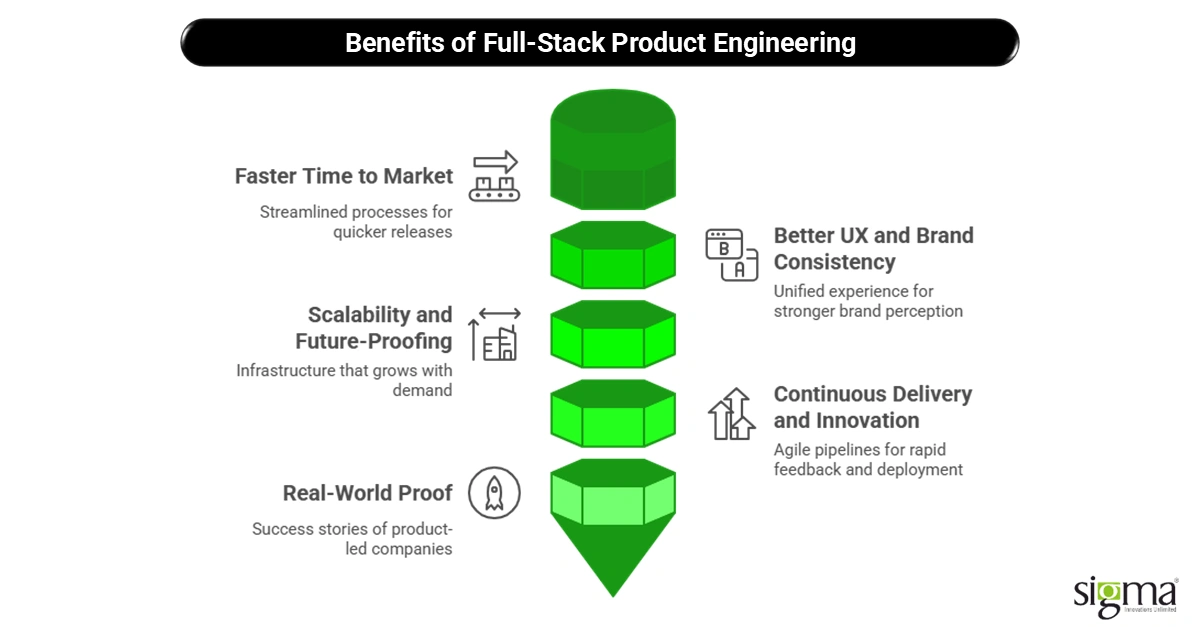
Faster Time to Market
When front-end, back-end, DevOps, QA, and cloud ops are all aligned, things move. Fast. Decisions are made quicker. Bugs are caught earlier. Features ship more reliably. A dedicated product engineering team minimizes handoffs and miscommunication, leading to streamlined sprints and quicker releases. For B2B players in FinTech and eCommerce, that kind of speed can be a game-changer.
Better UX and Brand Consistency
Disconnected teams often create disjointed experiences — one part of your app feels sleek, while another feels clunky or outdated. With software product engineering services, your team collaborates across the entire stack to deliver a unified experience. The result? Stronger brand perception and smoother user journeys that convert.
Scalability and Future-Proofing
Thanks to integrated DevOps and cloud infrastructure, your product doesn’t just work today — it scales for tomorrow. Modern digital product engineering services are built around automation, monitoring, and resilience, ensuring your platform grows with demand. Whether you’re targeting a thousand users or a million, you’ll be ready.
Continuous Delivery and Innovation
In today’s product landscape, staying still is falling behind. Full-stack engineering supports continuous integration and delivery pipelines, enabling faster testing, more frequent deployments, and rapid feedback loops. This opens the door to true agility — where innovation isn’t an event, it’s a cycle.
Real-World Proof – What Product-Led Companies Get Right
The most successful product-led companies — don’t silo their teams. They use cohesive, cross-functional models powered by product engineering solutions. This structure allows them to quickly validate ideas, adapt to user needs, and maintain a high standard of technical excellence.
They’ve shown the world what happens when design, development, and operations work as one:
- Faster delivery
- Stronger user engagement
- And products that evolve — not just survive
Also Read: Automating Ticket Resolution with AI-Powered Resolvify++
For growing companies, especially in sectors like Fintech product development outsourcing and product engineering for SaaS companies, that’s the kind of structure that builds market leaders.
So yes, full-stack product engineering isn’t just a buzzword. It’s the operating system of modern product success.
Full-Stack Product Engineering Vs Piecemeal Outsourcing
| Aspect | Full-Stack Product Engineering | Piecemeal Outsourcing |
|---|---|---|
| Approach | Integrated, end-to-end ownership | Fragmented, task-based delivery |
| Team Structure | Cross-functional teams (design, front-end, back-end, DevOps) | Siloed teams or individual contributors |
| Product Thinking | Cross-functional teams (design, front-end, back-end, DevOps) | Siloed teams or individual contributors |
| Speed to Market | Faster with continuous delivery & fewer handovers | Slower due to dependencies and integration gaps |
| Innovation Capability | High – teams collaborate across the stack | Limited – scope constrained to assigned modules |
| Quality & Ownership | End-to-end accountability improves quality | Diluted responsibility often leads to rework |
| Scalability | Designed for long-term growth and iteration | Requires re-engagement or patchwork scaling |
| Strategic Alignment | Acts as a partner in product success | Acts as a vendor for isolated deliverables |
The Building Blocks of Cohesive Product Engineering
Great digital products don’t come from random acts of coding — they come from systems that are built to work together. If you’re serious about scaling your platform, reducing rework, and accelerating delivery, it’s time to go beyond just hiring more developers. You need structure. You need synergy. You need full-stack product engineering services with cohesion at their core.
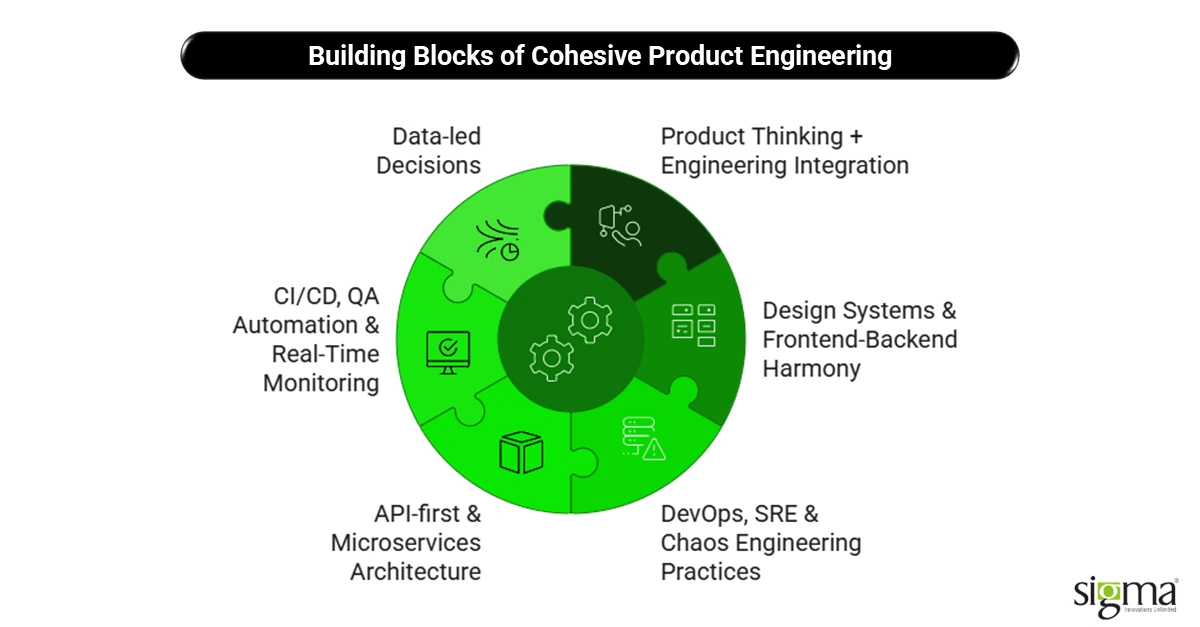 Let’s break down what makes that cohesion possible — the secret sauce behind successful software product engineering services.
Let’s break down what makes that cohesion possible — the secret sauce behind successful software product engineering services.
Product Thinking + Engineering Integration
You can’t engineer a great product if you don’t know why you’re building it. That’s why today’s dedicated product engineering team starts with product thinking. This means engineering teams are deeply involved in product strategy, not just implementation. Everyone understands the “what,” “why,” and “for whom.” It shortens the feedback loop and leads to more intuitive solutions — not just functional code.
Design Systems & Frontend-Backend Harmony
A button isn’t just a button anymore — it’s part of a design system. Consistency in UI components, patterns, and interactions leads to faster development and better UX. But design systems are just one part. The real magic happens when the front-end and back-end speak the same language — sharing schemas, services, and states. With product engineering services, this harmony creates seamless user experiences across platforms.
DevOps, SRE & Chaos Engineering Practices
Modern products need to run like clockwork — even when things go sideways. That’s why DevOps and Site Reliability Engineering (SRE) are baked into any good product engineering solutions approach. Add in chaos engineering principles, and you’re not just reacting to outages — you’re proactively stress-testing your systems for resilience. No more fragile codebases that break under pressure.
API-first & Microservices Architecture
An API-first mindset ensures your product is built for flexibility and future growth. Paired with microservices architecture, your platform becomes modular — easy to scale, test, and evolve. This structure is ideal for custom product development, especially in B2B and FinTech product development outsourcing where integrations are critical and change is constant.
CI/CD, QA Automation & Real-Time Monitoring
Speed without quality is a trap. That’s why full-stack teams rely on Continuous Integration/Continuous Deployment (CI/CD) pipelines, automated QA, and real-time monitoring. This trio catches bugs early, ensures fast rollouts, and keeps the team in sync with user behavior and system health. It’s the engine room of modern digital product engineering services.
Data-led Decisions – Using Analytics and Feedback Loops
Every click, every scroll, every drop-off tells a story. Software product engineering services teams harness product analytics, A/B testing, and usage patterns to guide what gets built next. You’re not guessing — you’re making data-led decisions that improve retention, engagement, and revenue.
Cohesion isn’t a nice-to-have. It’s the foundation of modern, scalable, and user-centered products. These building blocks aren’t theoretical — they’re real, proven, and available when you partner with the right product engineering services company.
When you put all of this together, your product team doesn’t just build — they build better. They build smarter. And they build for impact.
Trends Driving Full-Stack Engineering in 2025
In 2025, full-stack product engineering services aren’t just about staying current — they’re about staying competitive. Let’s look at the major trends shaping how digital products are built, scaled, and secured this year.
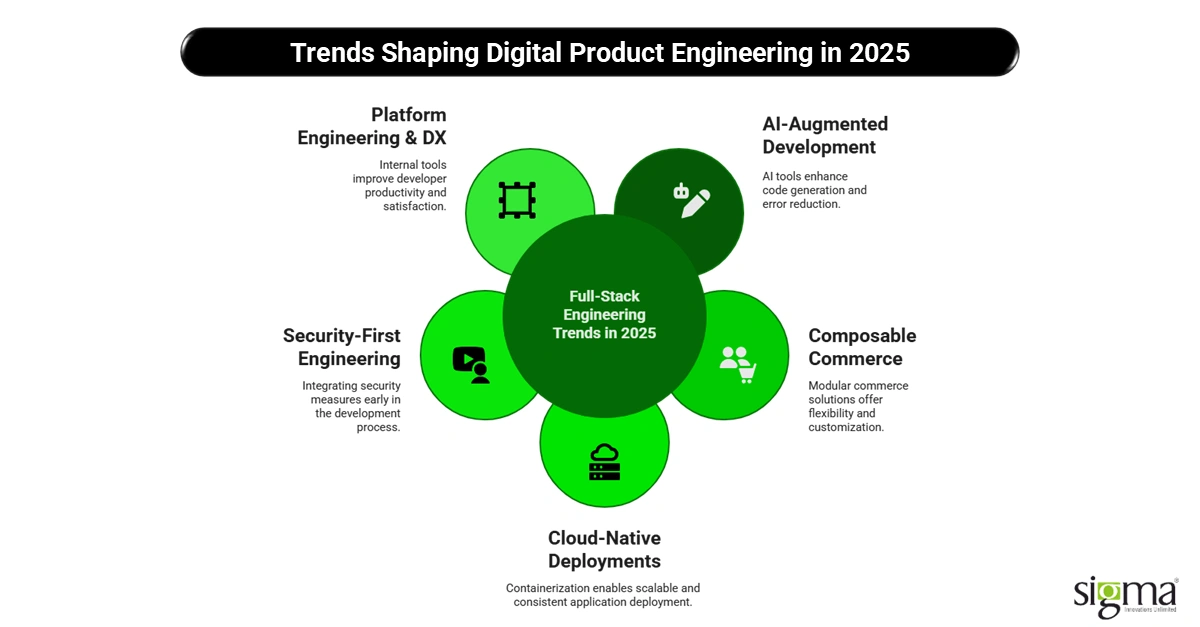
AI-Augmented Development
AI is no longer a sidekick; it’s part of the core team. Tools like GitHub Copilot and AI-powered testing frameworks are speeding up everything from code generation to bug fixing. For teams using software product engineering services, this means faster dev cycles, fewer manual errors, and smarter automation throughout the stack.
Composable Commerce & Headless Architectures
For businesses on platforms like Magento, Shopify, or BigCommerce, going “headless” isn’t just a trend — it’s a strategic move. With composable commerce, companies can mix and match best-of-breed services (like payments, search, and CMS) instead of being locked into rigid monoliths. This modularity fits perfectly with product engineering solutions built around APIs and microservices.
Cloud-Native, Containerized Deployments
Cloud-native isn’t optional anymore. With tools like Docker and Kubernetes, full-stack teams can package and deploy applications consistently across environments. Digital product engineering services built on containerization enable faster scaling, easier updates, and better resource management.
Security-First Engineering
In 2025, security starts with the first line of code. The “shift-left” approach brings testing and compliance checks earlier into the dev lifecycle. Whether it’s data encryption, secure APIs, or SOC 2/PCI compliance, product engineering services companies must now bake security into every layer of the product.
Rise of Platform Engineering & Developer Experience (DX)
Engineering teams today are also product teams — internal products, that is. With platform engineering, teams create internal tools and workflows that boost developer productivity. A better Developer Experience (DX) means faster delivery, happier engineers, and stronger product outcomes.
These trends are more than buzzwords. They’re the backbone of custom product development that drives innovation in industries like FinTech and enterprise eCommerce.
From Chaos to Cohesion – Our Approach at Sigma Infosolutions
At Sigma Infosolutions, we’ve seen the chaos — and we’ve solved it.
Whether it’s a fast-scaling FinTech startup struggling with technical debt or a global eCommerce brand grappling with platform limitations, we step in with one mission: bring order, speed, and clarity to product development. That’s what our product engineering services are built to do.
Built for eCommerce and FinTech Innovation
Our sweet spot? B2B companies operating in the high-speed lanes of FinTech and eCommerce. From Magento, Shopify, and BigCommerce development to custom product development for wealth platforms and loan origination systems — we know what it takes to scale secure, user-friendly digital products.
We’ve partnered with businesses across the U.S., Canada, and beyond to build everything from modular commerce engines to secure cloud-native fintech platforms — and we don’t just code and walk away. We take end-to-end ownership of your product lifecycle, from ideation and architecture to launch and continuous evolution.
Agile Teams with Full-Stack Firepower
Sigma’s dedicated product engineering teams are designed to move fast without breaking things. We operate with:
- Full-stack engineers who speak backend, frontend, DevOps, and user experience
- A DevOps-first mindset that accelerates deployment and improves reliability
- Continuous QA, monitoring, and feedback loops that power smarter iteration
It’s not just execution — it’s co-creation. We bridge product vision, design thinking, cloud-native development, and real-time delivery into one smooth, scalable engine.
Real Success, Real Results
Case in Point: A Global eCommerce Transformation
One of our clients, an electronics store, approached us for a seamless synchronization between SAP (Systems, Applications, and Products) and Magento platforms. We re-engineered their architecture using headless commerce principles on Adobe Commerce (Magento) and upgraded Magento 2 to the latest version (2.4.5). Result?
- 60% faster feature rollout
- 99.99% uptime and easy scalability
- 100% accurate data synchronization
That’s digital product engineering services done right!
Read the full success story: Headless Implementation with Magento 2.x for a Middle East-Based Electronics Store
Partner with us to build scalable, cohesive digital products. Whether you’re in FinTech, eCommerce, or SaaS — Sigma Infosolutions is your trusted product engineering services company for driving innovation, agility, and growth.
Final Thoughts
Let’s wrap this up with one clear message — chaos in product development isn’t inevitable. It’s optional. With the right strategy, team structure, and mindset, cohesion can be engineered.
In today’s fast-paced digital landscape, where product cycles shrink and user expectations grow, the old siloed models just don’t cut it. Companies need agility, cross-functional speed, and infrastructure that scales. That’s exactly what full-stack product engineering services bring to the table — a proven path from firefighting to future-ready.
Whether you’re in FinTech building scalable platforms or in eCommerce reimagining customer journeys, a cohesive software product engineering services model ensures you’re not just keeping up — you’re staying ahead.
CTOs, Product Leaders, and Founders — it’s time to rethink how you build.
Let Sigma Infosolutions be your partner in transforming product development into a growth engine.

